The Computer History Museum in Ljubljana, a private museum established in 2004, collects hardware and software of special significance for Slovene society. According to the Museum’s collection policy,14 objects made in Slovenia or by Slovenian inventors hold the highest priority within the collection criteria. The Computer History Museum in Ljubljana thus houses what is probably the largest collection of Slovenia-made computers. Even more than that the conservation and restoration departments, alongside the museum experimental laboratory are actively working their way towards making all of them operational again. This is a complex endeavor requiring discrete protocols and the involvement of various subject experts,15 and it includes digital archaeology as well as reconstruction efforts. This museum process thus offers a unique insight into the challenges and opportunities of software preservation.
During a routine backup of the hard drive of one such Slovene computer, we found a treasure trove of original software. Software is generally the hardest part of computer history to find and to preserve, because the majority of computers such museums work with do not have hard drives, and because floppy disks and other storage media were not preserved well technically or systematically by generations before us.
In this article, the author will explain the significance of what was found on this hard drive, and outline the complexities involved in the archiving of heritage software.
The Iskra Delta Partner Computer
In the year after the famous merger of Iskra and Delta16, six experts of the joint company took less than two months to develop a prototype of a desktop microcomputer they named Partner. It was intended mostly for new and smaller organizations, but was also marketed as a system for research activities, schools and even private individuals.
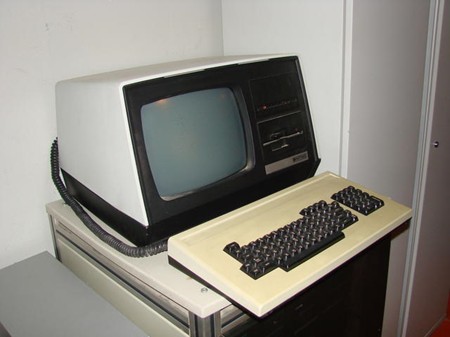
The Delta Partner was a desktop computer conceived as a practical business or development system, mostly used for accounting, bookkeeping and statistical processing. The computer could be integrated into networks with larger computers, where it functioned as a terminal as well as an independent system. After 1983 several models with identical basic characteristics and optional extensions for each model were being produced. The system was built on top of the then already somewhat out-of-date 8-bit microprocessor Zilog Z80A with a 4MHz measure, usually containing 128KB RAM memory and 8KB ROM memory.17
The Partner computer was sold in a bundle with dedicated software, initially consisting of only four user programs and an operating system, CP/M 3. The four MIPOS user programs served individual or integrated business data processing needs. They enabled bookkeeping through a main book, accounts for both customers and suppliers, but also warehouse logistics management and invoicing. The software tools gradually enabled other office work, such as text document processing, and more tools were also released to support scientific calculations in the fields of energy management, machine engineering, and construction, as well as tools for assisting processing technology in the food-processing and pharmaceutical industries. These were offered in addition to software for interactive programming, classical compilers for Cobol, Basic, Pascal and C, and a macro-assembler for symbolic machine language. The first versions of the system only displayed text, but newer ones were enhanced with a graphics card with a resolution of 1024×512 points. Data could thus be shown in graphic format with the help of the BGRAF, IDRIS and DIAS program packages. Among the first three versions of the Partner computer, the WF/G model was available with a floppy disc drive and a 10Mb Winchester disc, while models 1F/G and 2F/G were available with one or two floppy disc drives. All Partner computers had a serial port intended for connecting with a printer and mouse, and it was also possible to install additional ports. Usually the system included a TRS835 printer, and other expansions included a network port and video-out port.18
Production was first established in the city of Kranj, and later moved to Ptuj. Production for western markets was gradually set up in Delta’s new Austrian factory, and a special model of Partner with a different software programs package was produced by Novkabel in Novi sad. In August 1983, the first ten systems out of the regular production line were ready for testing and by the end of the year 170 systems had already been assembled in Kranj. A total of 200 units were sent to the Austrian St. Jakob plant, where at least 100 Partners were to be assembled by the end of year for export. Out of all the Slovene computers, this was by far the most widely adopted model, the total production number being several thousand Partner computers, while the planned production was up to 10,000 systems. According to the 1988 registry of computer equipment,19 approximately 450 Partners were still being used in Slovenia. Today, we know of 12 Partner computers, and expect at most two or three times more to be stored by private collectors or just waiting in garages to be found.
A handful of schools in Slovenia had a classroom equipped with Partner computers, the first amongst them being the Technical high school in Kranj. The computer course there in the late 1980s was run by the future head of the machine learning research department at the Jožef Stefan Institute (Institut “Jožef Stefan” – IJS), Marko Grobelnik.20
Emulating the Partner environment
The demise of Iskra Delta, the dissolution of Yugoslavia, transition to capitalism and the advance of IBM PC architecture made Partner obsolete, and soon also practically forgotten.
In 2018, a student of computer science in Slovenia reverse-engineered the internals of the computer and wrote an emulator which enabled the original software to run again for the first time in 25 years.21 This student, Matej Horvat, is also part of the Computer History Museum team, with a special expert focus on Partner computers.
Since then a small community of “Part-Time Nerds”22 has taken on the challenge of writing new software for Partner computers using this emulator. Horvat’s emulator also runs in an online environment, so we were able to put it on the museum webpage for anyone to try.23
Partner software is a rarity and a historical curiosity
The emulator was written using a Partner computer that the University of Ljubljana Faculty of Computer and Information Science had carefully preserved. Their and ours are the only two Partner computers we know of that still have a functional hard drive, making them the only two sources of original software to date.
The complete list of currently preserved software contains some Microsoft programming languages, some original Iskra Delta productivity software, a partially localized WordStar text editor and a number of user-written applications.
One of the most interesting examples of original development the Computer History Museum found in its media archaeology endeavors is a version of a game Snake,24 called Glista.25 It came with impressively extensive documentation. Here is a translation of its splash screen which clearly describes the intentions of the author, thus encapsulating a certain human effort of the time:
“This game was created as a means to manage boredom, which usually happens during school classes (and during breaks). It doesn’t make any sounds other than the clicking of the floppy drive. If you disable ‘click’ it will be completely silent (verified). The game doesn’t require much focus, so you can still follow the professor with the left side of the brain. If at first you don’t manage to get many points and are losing hope, know that only practice will help you get better.”
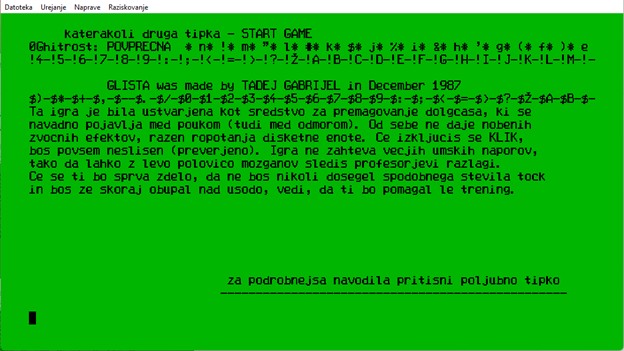
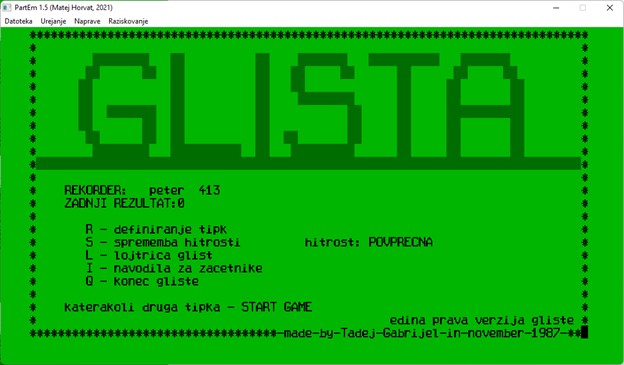
So yes, it’s “just” a game, and a copy of a well-known game, at that, but the attention to detail and the specificity of the user scenario encouraged us to look deeper.
Archiving software as a core museum procedure
At this point, please allow the author a short deviation to explain how we understand software archiving at the Computer History Museum. As we presented at the annual NetPreserve Conference,26 our job as museum professionals is to preserve as much as possible for future generations of researchers. In one dimension we are interested in as much “information” being preserved as possible. In another we look at the aura of the physical objects. But our job is also to maintain the knowledge necessary for technical understanding of the objects, and to communicate with the public. We do all of this when we manage to bring a piece of code all the way to live reconstruction.
For some examples of the various stages involved in this, here is a mock-up, a design document, for text-based software that would probably run on a Partner computer:
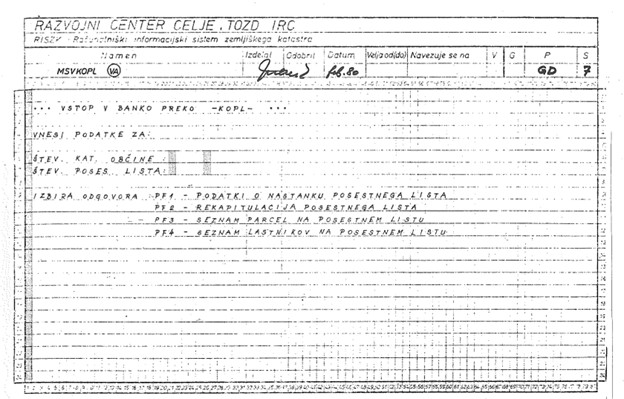
At another extreme, here is a complete production rack of Slovenia’s largest BBS. The Computer History Museum team claimed it directly from the room in which it was last running live and serving users, and we are currently working on disk recovery. This is an example where software was off-the-shelf, but the communication and data left on the server by the users is invaluable.
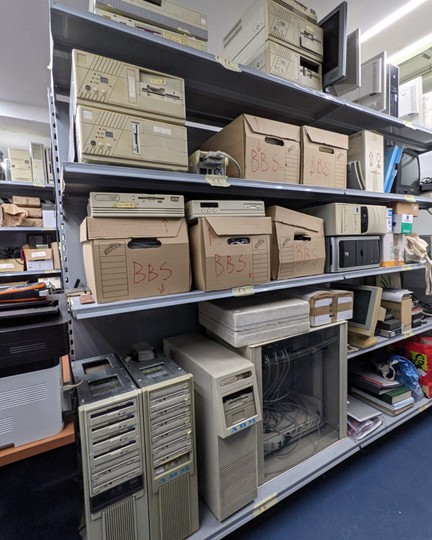
We follow the stages of software preservation as follows:
- Evidence of its existence. Mentions in interviews or contemporary articles.
- Documented inputs & outputs. Screenshots or manuals.
- Binary files. Often salvaged from disks and tapes.
- Binary + data. Taken from some kind of production environment.
- Source code.
- Bonus: original hardware.
- Extra bonus: the actual original machine that ran this specific software.
The ultimate goal after any stage is live reconstruction. Every higher level of preservation makes the reconstruction easier, more possible and more complete. In practice we feel extremely lucky every time we are able to get to at least the (3) binary level, and thus beyond just evidence of existence.
The programs we found on the only two Partner computers known to have a hard drive were all in binary form, allowing us to run them on the original hardware or in an emulator. They give us a glimpse into how the software was used, but not into the authors’ way of thinking.
Glista is an exception, because it had so much attention to detail that it included the full documentation, the splash screen with motivation that we shared above, and on top of all this the software was signed.
The inseparable entities of the user and the machine
Our research department likes to interview the users and authors whenever possible, so we have a record of first-hand experiences. However, the opportunity to do this is extremely rare.
We sought out the author of Glista, who is now a high-ranking bureaucrat at the Ministry of Public Administration. He visited the museum, and we could show him a working Partner computer, the actual computer he last used 35 years ago at that Kranj high school, under the supervision of professor Grobelnik.
Mr. Gabrijel is a very serious person, and the attention to detail in Glista shows that even back in his high-school years he was taking fun very seriously, as well. When reunited with his software he was sincerely touched by the experience and thanked us deeply afterwards.
Conclusion
This demonstrates the human aspect of software preservation, and the ability of software to provoke emotions. For the software creator the running code is a part of their self, encapsulated in digital form, as much as an artwork is for an artist.
Software heritage is the heritage of human ingenuity. It encapsulates the spirit of homo sapiens as we have known it in recent centuries, and it testifies to the rise of the possible future of homo digitalicus.
Postscript
Partner computer internals don’t allow for the representation of dates after 1999, so Horvat decided to fix that in the emulator by resetting any date that might be in the 21st century back to the base from 1990.
The programs in the emulator are thus running in a perpetual 1990s – a golden era for computing that Partner computers never actually experienced, because PCs took over the market, and because Iskra Delta filed for bankruptcy in 1990, starting the first liquidation process in independent Slovenia, one that only ended in 2020. Unfortunately, the liquidation manager destroyed all technical documentation early in this process.
Glista, however, will now live forever inside our Partner emulator, partying like it’s still the 1990s.
14. Computer History Museum, Zbiralna politika (internal research documentation), Ljubljana 2019
15. The Computer History Museum collaborates with an international network of experts for various subset level expertise access, but in the case of Slovene computers the expertise is entirely homegrown.
16. In 1981, after years of searching for a sensible solution that would prevent the duplication of development and work between several companies in the country.
17. Computer History Museum, internal research documentation, Miha Urh 2022
18. Computer History Museum, internal research documentation, Miha Urh 2022
19. M. Hlavaty, Zmogljivosti in uporaba opreme za avtomatsko obdelavo podatkov 1988, Zavod RS za statistiko, Ljubljana, 1990
20. Grobelnik
26. Netpreserve.org International Internet Preservation Consortium General Assembly & Web Archiving Conference 2022